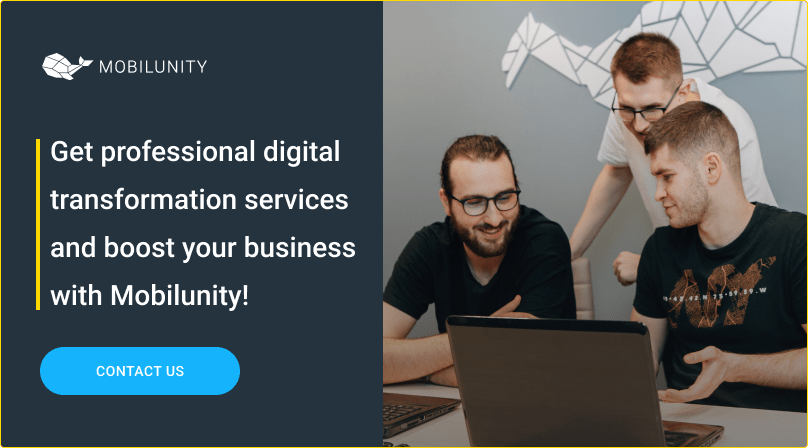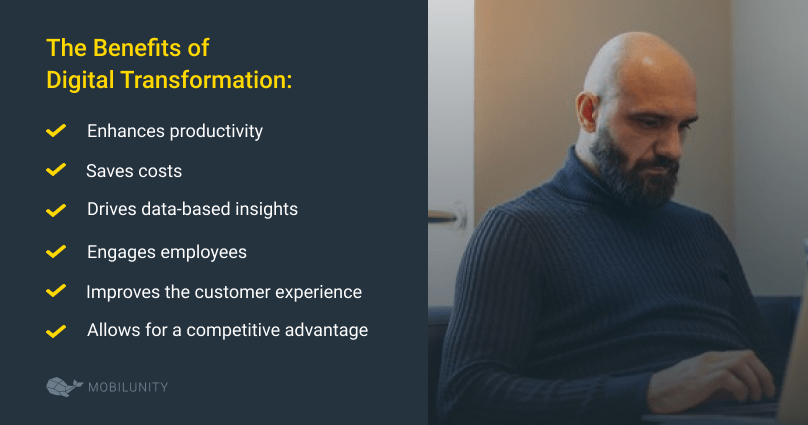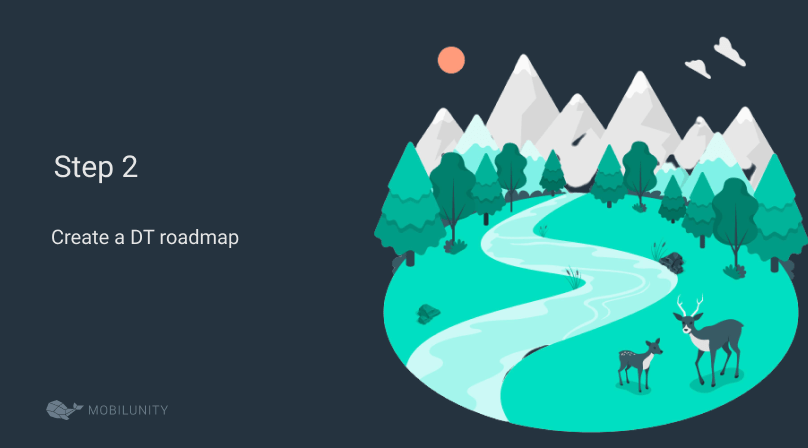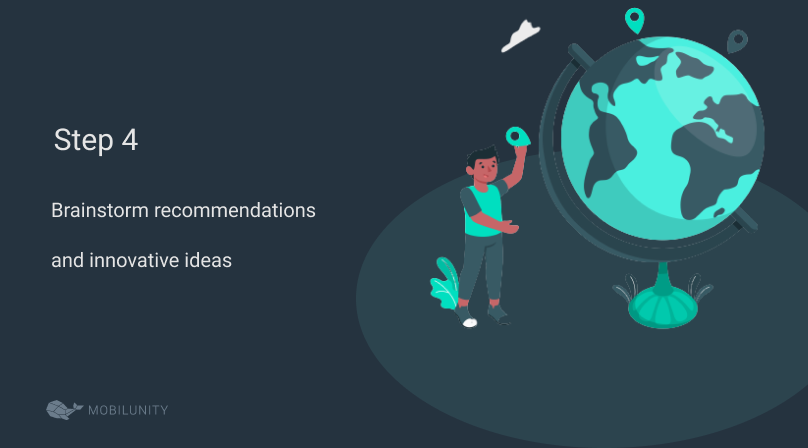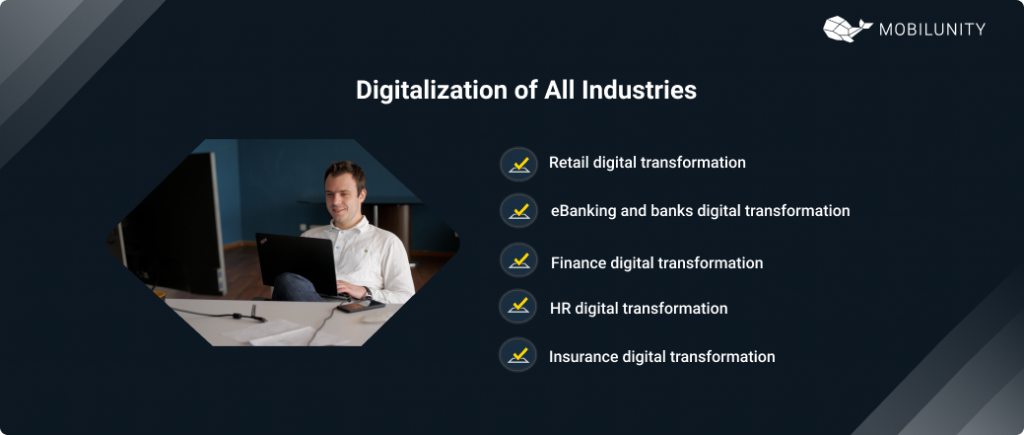Digital Transformation Services & Consulting for Your Business
Digital transformation (DT) services are used to modify a business to suit the digital age requirements. Such services involve using digital technologies to create new or adjust current business processes and customer experiences. As a result, it completely changes the way businesses are managed, and the approaches used to solve common issues, and how value is offered to customers.
Planning and building digitally set businesses up to be agile and ready to expand. However, because it’s an evolution, digital transformation doesn’t always have a specific endpoint. Therefore, it is better thought of as constant change to a certain environment. For businesses, this means continually identifying ways to enhance end-user experiences. This includes providing on-demand training, transferring data to cloud services, and implementing artificial intelligence and other advanced digital technologies.
Ultimately, digital transformation is essential for modern businesses as it allows them to adapt to ever-changing markets and continuously improve how they function.
The Benefits of Digital Transformation for Businesses
The right digital transformation technology can significantly improve how businesses function and how customers engage with them. Let’s explore all the benefits involved in investing in DT technical consulting services:
- Enhances productivity. One of the most impactful ways to transform a business is using technology to work more efficiently. The way employees communicate between departments, the flow of data across the business, and the customer’s life cycle phases can all be improved by implementing digitalization technologies.
- Saves costs. For many businesses, the main driver for digital transformation is the cost savings involved. Migrating data to a cloud environment reduces operational costs and lowers hardware and software costs.
- Drives data-based insights. Going digital allows for the effective tracking of metrics and analyzing data gained during digital marketing efforts. Using these insights enables businesses to improve their strategies for even greater results. It allows them to understand customers, enable personalization and real-time feedback.
- Engages employees. Digital technologies can be utilized to attract new talent and retain current employees. They can be used to address performance reviews, coach SW developers, offer support and identify areas of improvement.
- Improves the customer experience. Today, a great experience is one of the main aspects customers seek when choosing businesses. They want convenient processes to engage with these businesses, including mobile apps, live chat, and social media. Digital transformations can drive these enhanced experiences for customers.
- Allows for a competitive advantage. Developing the infrastructure of a business with digital technologies increases the advantage it has within its industry. The key is to identify areas where a business can improve and implement new processes to differentiate itself in the modern business world.
Considering these benefits, it is unsurprising that direct investments into digital transformation are predicted to reach $7.8 trillion between 2020 and 2024.
The Steps Involved in Adopting a DT Strategy
Like any other implementation, a successful DT process involves a certain approach and a well-defined digital transformation roadmap.
Step 1. Analyze the IT strategy and discover pain points
Setting up a vision and identifying specific employee and customer needs is the first step to digital transformation. The current IT strategy should also be analyzed to identify which pain points are already solved and require improvement
Step 2. Create a DT roadmap
Long-term goals and short-term objectives should be included in a realistic enterprise digital transformation roadmap. Thereafter, the DT technologies should be identified to meet these needs and objectives successfully. These can include:
- Apps. An explosion of access to smartphones has increased the need for mobile apps to improve customer experiences.
- Cloud computing. These tools increase the efficient work of teams online, allow for storing large amounts of data, and maintain a high level of security.
- Internet of Things (IoT). IoT exchanges data with other devices to offer the best user experience to employees and customers.
- Digital documentation. This involves documenting traditional reports and records digitally for easy access by everyone involved in specific projects and processes.
- Artificial intelligence and machine learning. These technologies help to automate tasks and provide analytics at a previously inaccessible level.
Step 3. Confirming a budget
Budgeting is an incredibly important step for any business that wants to transform digitally. It helps to identify which technologies are most suited for a business and the size of the dedicated team required. A budget should include:
- The DT tech consultant hourly rate.
- The cost of investing in DT technologies.
- The cost of resources and hardware required.
- The cost of launching or implementing the DT project.
- The cost of risks involved.
Step 4. Brainstorm recommendations and innovative ideas
DT projects typically require several specialists or teams across departments, but there are four primary DT roles:
- Chief Information Officer (CIO). The role of the CIO role is to lead business strategies and DT initiatives. Some of the responsibilities of a CIO include establishing objectives for DT, analyzing the costs involved, designing a digital transformation strategy, and overseeing the implementation thereof.
- Digital Transformation Specialist. Digital transformation specialists find ways to use technology to heighten a business’s technical performance and help them to stay competitive. This specialist’s main responsibilities include advising on DT initiatives to benefit the business and offering strategic advice for implementing and managing transformations.
- Digital Adoption Manager. A digital adoption manager manages a business’ digital strategy and identifies methods to help employees learn new technologies and ensure they know how to use digital tools.
- Digital Product Manager. A digital product manager takes control of the entire digital product life cycle. The responsibilities of this role include identifying opportunities for new products, creating strategies for developing digital products, and tracking the performance of digital products and processes.
Step 5. Finding the right dedicated team

Finally, a business has to hire a consulting company, such as Mobilunity, to access a dedicated digital transformation consultants team to implement the above steps. Mobilunity offers top talent at cost-effective rates that work closely with businesses to meet their digital transformation needs.
Digitalization of All Industries
Retail digital transformation
The COVID-19 pandemic has greatly influenced the sales industry. And digital transformation, either of physical stores and markets or other businesses that operate with purchases and payments, is inevitable. Whether you provide the opportunity for contactless payments to your customers if your business is a physical store or use innovative analytical instruments to better understand your clients and forecast their future behaviors, digital transformation will leverage your business to the next level!
eBanking and banks digital transformation
In our time, nothing stays in its place, and in order to stay successful and keep afloat, banks should invest in their digital transformation. Today’s fast-developing fraudulent schemes bring serious risks to all the banking sphere, so adequate and preemptive measures against them. Start the digital transformation in your bank, and you will become way more protected from today’s fraudulent schemes, and, thanks to the new smart algorithms, will avoid giving loans to fake startups!
Finance digital transformation
Finance can’t exist without digital transformation as well. It’s all about its very nature: finance can only move with time, and today’s time is ‘asking’ for finance’s change, i.e., its digital transformation. And finance digital transformation is of many traits: the visualization of data in real-time, blockchain, finance and business analytics supported with AI, and of course, robotic process automation. Should you want this all to be implemented with utmost quality, Mobilunity is to your service!
HR digital transformation
Digitalization embraces nearly all the spheres, and even the sphere of HR has not stayed untouched. Searching for new workers, choosing the right candidature, as well as consulting new hires on their new workplace’s culture are among the most popular queries that can be efficiently automated.
Insurance digital transformation
And could it ever be possible that insurance businesses miss out on digital transformation? Of course, not, as in the sphere where service speed and customer comfort are much important. Today, already many insurance companies use digital products, such as applications and sites, to handle their business. Still, the demand for further digitization will stay, as there is a constant need for speed in this business.
What to Look for When Choosing the Perfect DT Provider
The success of implementing a DT project will depend on choosing the right information technology management consultant company. Businesses have to consider the following points when looking for a company or agency:
- Digital transformation companies should have the relevant expertise for a business’ unique project. A company’s previous projects must be analyzed to see if they have sufficient process-specific, technical and industry-specific expertise.
- The digital transformation consulting company should provide updated resumes of individual information systems consultants and freelance business analysts to ensure that they have the necessary skills, knowledge, and experience.
- Reviews of the company’s digital transformation services should be assessed to see if they have a good reputation with other businesses.
- Communication methods should be reviewed early on to ensure no information is lost when working with the digital transformation agency.
Moving to a Digital Environment With Mobilunity
Ukrainian-based outstaffing company Mobilunity has more than 10 years of experience helping businesses, big and small, in a wide variety of industries with dedicated teams. These teams assist businesses with superior solutions related to software development projects and complete digital transformation.
At Mobilunity, our approach includes accepting new challenges, improving businesses’ operations, and delivering efficiency to our clients. Some of our clients include Byg-E in Denmark, XPLG in Israel, ICUC in Canada, and Network of Arts in Switzerland.
Our process includes the following steps:
- Recruiting
Our team selects the best candidates to complete a test task and pass interviews.
- Onboarding
We assist with setting up essential settings and processes to ensure smooth onboarding for workers.
- Ongoing support
Our team makes sure all contractual obligations are met and assist with ongoing requirements to ensure a successful partnership.
If you’re ready to use digital transformation solutions to take your business to the next level, speak to Mobilunity. Get professional help effortlessly.
All salaries and prices mentioned within the article are approximate NET numbers based on the research done by our in-house Recruitment Team. Please use these numbers as a guide for comparison purposes only and feel free to use the contact form to inquire on the specific cost of the talent according to your vacancy requirements and chosen model of engagement.
